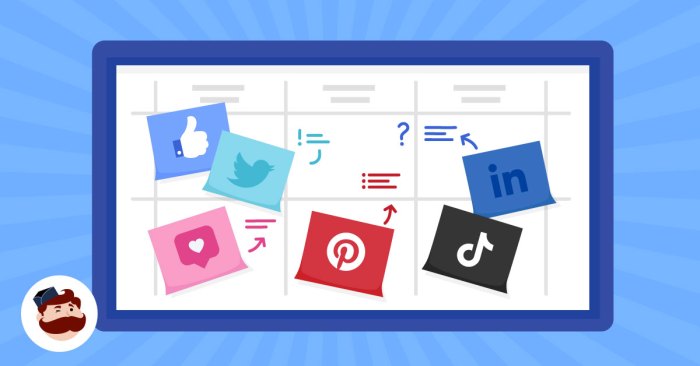Developing a Social Media Posting Schedule, let’s dive into the world of strategic online presence with a plan that rocks the digital space. Get ready to elevate your social media game like never before.
Creating a schedule that speaks volumes, understanding the tools to master your content, and analyzing data like a boss – it’s all about maximizing your impact in the online realm.
Importance of a Social Media Posting Schedule
Having a social media posting schedule is crucial for businesses to maintain a consistent online presence and engage with their audience effectively.
Benefits of a Social Media Posting Schedule
- Consistency: A well-planned schedule helps businesses post regularly, keeping their audience engaged and interested.
- Visibility: By posting consistently, businesses increase their visibility on social media platforms, reaching a wider audience.
- Brand Awareness: Regular posts help in establishing brand awareness and recognition among followers.
- Engagement: A posting schedule encourages interaction with the audience, leading to higher engagement rates.
Improving Engagement and Reach
- Optimal Timing: By following a schedule, businesses can determine the best times to post for maximum engagement.
- Content Planning: A posting schedule allows for strategic content planning, ensuring that posts are relevant and engaging.
- Tracking Performance: With a schedule in place, businesses can track the performance of their posts and make necessary adjustments to improve reach and engagement.
Creating a Social Media Posting Schedule

To create an effective social media posting schedule, follow these steps:
Step 1: Know Your Audience
- Research and understand your target audience demographics, behavior, and preferences.
- Identify the platforms they use the most and the times they are most active.
Step 2: Set Goals and Objectives
- Determine what you want to achieve with your social media posts (e.g., brand awareness, lead generation, website traffic).
- Set specific and measurable goals to track your progress.
Step 3: Choose the Right Platforms
- Select the social media platforms that align with your audience and business goals.
- Focus on quality over quantity to maintain a consistent presence.
Step 4: Create a Content Calendar
- Plan your content in advance, including post topics, visuals, and captions.
- Use tools like Hootsuite or Buffer to schedule posts ahead of time.
Determining the Best Times to Post
To determine the best times to post based on your target audience:
- Use analytics tools provided by social media platforms to track engagement metrics.
- Experiment with posting at different times and days to see when your audience is most active.
Balancing Promotional and Engaging Content
It is important to balance promotional and engaging content within your schedule:
- Follow the 80/20 rule – 80% engaging content and 20% promotional content.
- Create a mix of posts that provide value to your audience and promote your products or services subtly.
Tools and Resources for Managing a Posting Schedule
In today’s digital age, managing a social media posting schedule can be made much easier with the help of various tools and resources available. These tools not only help in scheduling posts but also provide analytics and insights to improve engagement and reach.
Popular Social Media Management Tools
- Hootsuite: A comprehensive platform that allows scheduling posts across multiple social media channels, monitoring conversations, and analyzing performance metrics.
- Buffer: Known for its simplicity and user-friendly interface, Buffer enables scheduling posts, tracking performance, and collaborating with team members.
- Sprout Social: Ideal for businesses, Sprout Social offers scheduling, monitoring, and reporting features to streamline social media management.
Features of Social Media Management Tools
- Post Scheduling: Allows users to plan and schedule posts in advance, ensuring a consistent presence on social media.
- Analytics: Provides insights into post performance, audience engagement, and follower growth to optimize content strategy.
- Team Collaboration: Enables teams to work together on creating and scheduling posts, ensuring a cohesive social media strategy.
Automation for Streamlining Posting Schedule, Developing a Social Media Posting Schedule
Automation plays a vital role in maintaining a consistent posting schedule by eliminating the need for manual intervention. By using automation tools, businesses can schedule posts at optimal times, recycle evergreen content, and engage with the audience without being constantly online.
Automation tools such as Zapier and IFTTT can be integrated with social media platforms to automate tasks like sharing new blog posts, responding to messages, and tracking mentions.
Analyzing and Adjusting Your Posting Schedule: Developing A Social Media Posting Schedule

It’s crucial to regularly analyze the performance of your social media posts to ensure you’re reaching your audience effectively.
Tracking Engagement Metrics
Tracking engagement metrics allows you to evaluate the effectiveness of your posting schedule and content strategy. Here are some methods to help you track and analyze your social media performance:
- Monitor likes, comments, shares, and clicks on your posts to gauge audience interest and engagement.
- Use social media analytics tools provided by platforms like Facebook Insights, Twitter Analytics, and Instagram Insights to track key metrics.
- Track website traffic and conversions from social media posts using tools like Google Analytics to assess the impact of your social media efforts on driving traffic and conversions.
Making Data-Driven Decisions
After analyzing the data from your engagement metrics, it’s important to make data-driven decisions to optimize your posting schedule. Here’s how you can adjust and optimize your posting schedule based on the insights gained:
- Identify the best times to post by analyzing when your audience is most active and engaged with your content.
- Experiment with different posting frequencies and timings to see what works best for your audience and generates the most engagement.
- Consider the type of content that performs well and tailor your posting schedule to focus on creating more of that content.
- Continuously monitor and analyze your social media performance to make ongoing adjustments and improvements to your posting schedule.
